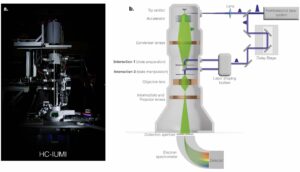COFFEI
Coherent control Of Free electrons For Enhanced ultrafast nano-Imaging
Research project selected under the 2023 call for proposals
Principal Investigator : Hugo LOURENÇO-MARTINS
Involved Teams :
- CEMES / Nano-Optics and Nano-materials for optics – NeO
Type of project : Disruptive Project
Date (start/end) : 2023 – 2026

Ultrafast Transmission Electron Microscopes (UTEM) have enabled to study excitations of materials and nanophotonic systems with ultimate spatio-temporal resolutions. However, the techniques available to shape electron beams in the temporal, spectral or spatial domains, a pre-requisite for coherent control experiments, are very limited. The COFEEI project proposes to boost the possibilities of shaping electron beams in the temporal, spectral and spatial domains by exploiting the inelastic interactions between femtosecond electron pulses and shaped optical beams.
The project will rely on a unique UTEM prototype – HC-IUMI (see figure) – developed in the framework of a joint laboratory between CNRS and Hitachi-High Technologies. This UTEM benefits from the unique laser-driven high brightness electron source technology patented by CEMES. More importantly, it also has a unique asset which has not been exploited yet in any laboratory around the world: the possibility of having electrons and light interact twice along the path from the electron source to the detector.
This unique experimental configuration paves the way to versatile coherent control experiments in which the electrons are shaped by an interaction with a first laser pulse in a first region before interacting a second time with light and the sample in a second region. It is the objective of the COFEEI project to perform for the first time these experiments. If successful, it will enable the generation of attosecond electron pulses and realization of Ramsey-type coherent control experiments with 400 fs, sub-nanometer electron pulses opening unexplored perspectives for coherent control experiments at the nanoscale.
